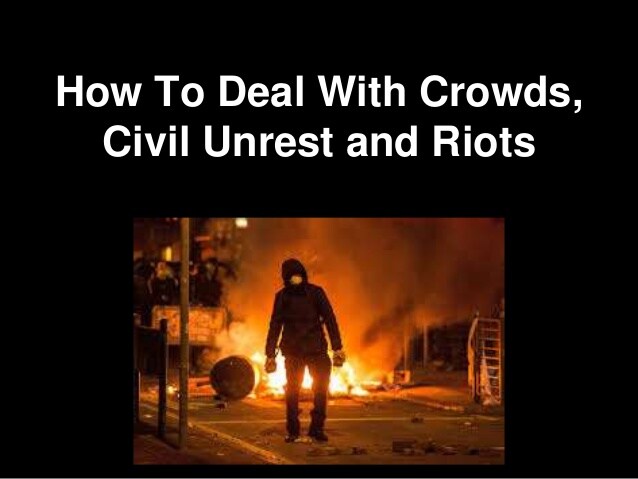Crowds act differently than individuals. What was a peaceful protest or event can quickly escalate. No matter what your role, even as an innocent bystander, it pays to be prepared. Also, you can unexpectedly become caught up in an incident while in transit from work, school or traveling.
This also applies to any crowded environment where things can get out of control: Sports events. Concerts. Movie theaters. Any time there is a crowd, there is a possibility for an incident that will get out of control. People have been killed and hurt at these events.
On the left is the crush at the Hillsborough Soccer match where poor crowd control led to a crush that killed 96. On the right is the Station Nightclub Fire which killed 100. Any gathering of a number of people can turn dangerous in a myriad of ways.
11 people were killed at a Who concert because of the crush for festival seating. 39 people were killed at a soccer match in Belgium while trying to escape a fight between fans. 96 people were killed at a soccer match in England when fans were channeled into too tight a space with no exit. Crowded night clubs have often been the scene of disasters. The Station fire in Rhode Island killed 100 people when pyrotechnics started a fire. Many died rushing for the same door and getting caught in the stampede.
Think about what would happen if a fire broke out or an active shooter occurred at any large event. Always know where the exits are. Have a plan to get out. Remember: people will instinctively go toward the way they came in. Find the emergency or other exits as soon as you enter any venue. Make sure you can find them in the dark and in a panicked crowd. If going with a group, make sure you have a rally point outside the venue to meet at, even if just in case someone loses their cell phone.
Know the area where you live, work, and go to school. Check out and know alternate routes. Get familiar with the area. Check maps by looking at your phone apps. Every so often, take a different route to familiarize yourself with alternatives. You might even find a faster way. If driving, make sure you have a physical street map. If you can prepare and have to travel through an area that might have a riot, carry a solution for rinsing your eyes out in case of tear gas. Make sure you have identification.
The best way to avoid problems is to avoid the riot. Social media, hashtags and local media can give warning of where crowds are gathering. Avoid places where security forces/police are gathering.
Eye protection is critical as rubber bullets are not soft. The same with gas pellets fired by ‘paintball’ guns. If either strike your eye, you can lose your vision. In 10th Special Forces, we were issued ballistic eye armor at one point, both clear and shaded, to protect our eyes during close quarters battle drills (room clearing). While it might be tempting to film things, this also puts you in the line of fire of whatever you’re filming.
Note the gear an experienced protestor has. For those not involved and bystanders, consider which parts of this you can improvise for your own protection. Do not shine laser pens into anyone’s eyes.
When traveling, aim for as many crossroads as possible because they give you three options to go in. Try not to get channelized. Remain calm. Hide. Avoidance is always best. Blend in while moving away. Avoid law enforcement if they have donned their riot gear because they will tend to arrest first and ask questions later. If you must pass through rioters/looters/etc. wear long sleeves, long pants, consider a motorcycle, bike or other helmet.
Walk, don’t run, as you might attract attention. Don’t make eye contact. Don’t confront people. Don’t stop. If you’re with someone from your team, hold hands tightly. Don’t get involved. It’s not your riot. Stay close to walls, on the edges of crowds. Avoid bottlenecks.
If you’re in your car, back up and get away from any crowds. Never attempt to drive through. If you are caught in a crowd, don’t drive through, speed up or act aggressive. Keep your doors locked and your windows up. Riots usually happen on streets, not in buildings. Get off the street and into a building. Stay away from windows. Look for another exit. Be careful of fire.
If necessary, on foot, go with the flow. Become part of the crowd and edge your path away from the violence. Don’t go against the flow of the crowd. Walk away; don’t run as it will draw attention. Avoid being filmed as much as possible. Remember there is CCTV everywhere. Keep your head down. Cover your face. Even if innocent, you can be considered a suspect.
If pushed to the ground, curl into a ball. Cover your head with your arms and remain still until the crowd moves away. If possible, try to get against a wall. If shooting breaks out, drop to the ground, lie flat, and cover your head with your arms. Try to find any cover close by. Underneath parked vehicles works.
If arrested, do not resist. Go along peacefully. If overseas and arrested try to contact the embassy immediately. Civil Unrest and Riots


Recent Comments